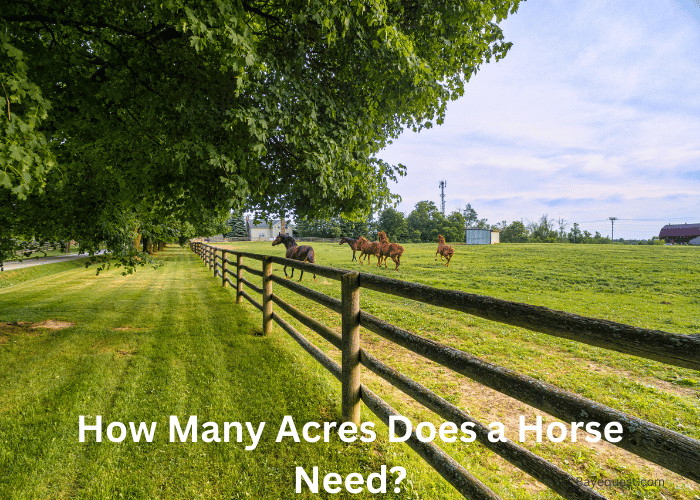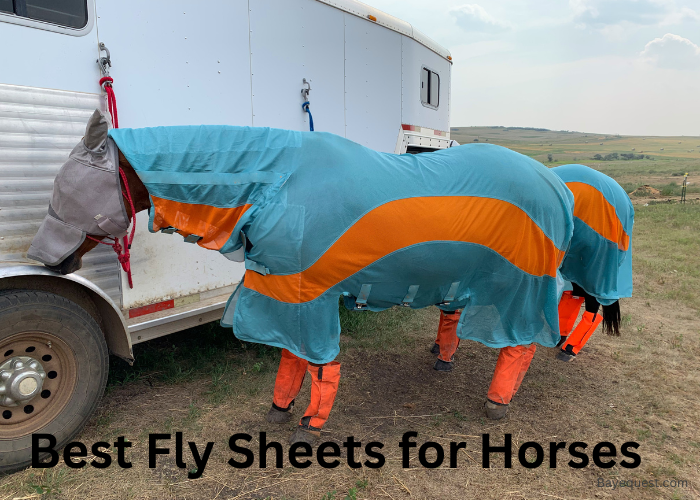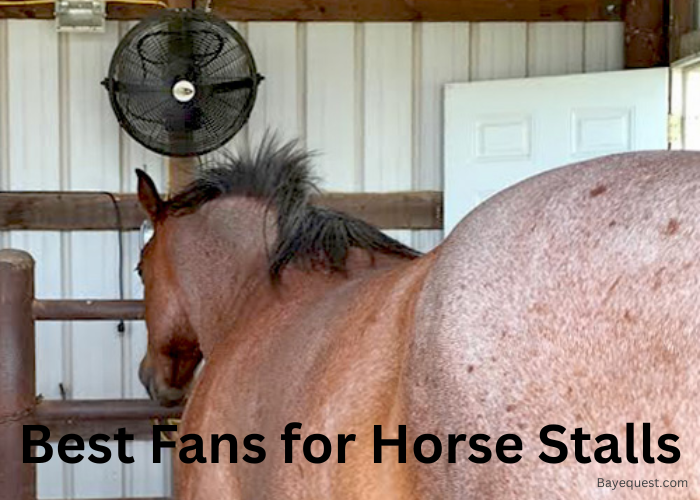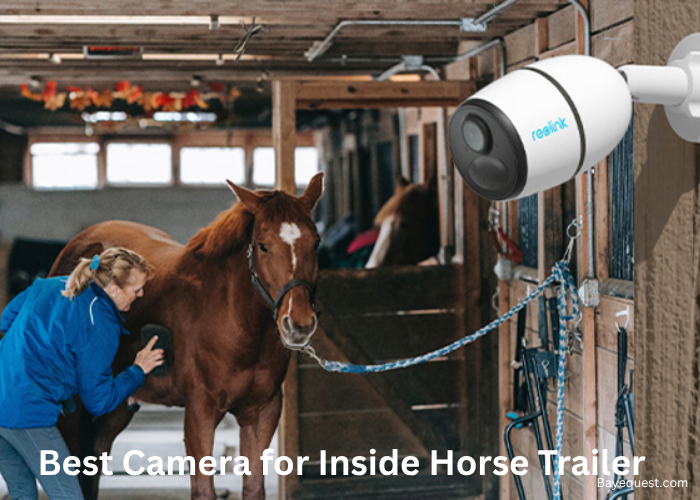Ever wondered how much space your horse needs to roam free and stay happy? You’re not alone. Figuring out the right amount of land can be a bit tricky.
Too little, and your horse might feel cramped. Too much, and you’re wasting valuable space.
In this blog, we’ll break down the basics in simple terms. We’ll cover the key factors and give you a clear idea of how many acres your horse needs.
Let’s dive in and find that sweet spot for your four-legged friend.
How Many Acres Does a Horse Need? Key Takeaway
A horse generally needs 2 to 4 acres of good quality pasture. This larger space helps prevent overgrazing and maintains healthy soil. It also allows for better pasture rotation, giving the grass time to recover and reducing the risk of mud and erosion. With more room, horses have plenty of space to roam, graze, and exercise.
Factors Influencing Acreage Requirements
Curious about what affects how much land your horse needs? Here are the key factors that play a crucial role.
Number of horses
The more horses you have, the more land you’ll need. Each horse requires space to graze and move around.
Overcrowding can lead to overgrazing, damaging the pasture. Ensuring enough space per horse helps maintain a healthy environment.
Type of land
The quality of the land greatly affects how much space a horse needs. Fertile, well-maintained land supports more horses per acre.
Poor, rocky soil may not provide enough nutrition. Quality pasture means healthier horses and less need for supplemental feeding.
Climate and weather
Climate plays a big role in pasture management. In wetter climates, land can become muddy and overgrazed quickly.
More acreage allows for better rotation and recovery of the grass. Dry climates may need irrigation to maintain pasture quality.
Horse breed and size
Different breeds and sizes of horses have different space needs. Larger breeds require more room to move and graze. Smaller horses or ponies might need less space.
Knowing your horse’s breed and size helps in planning the right amount of land.
Horse activity level
Active horses need more space to run and exercise. Horses used for riding, training, or work require larger areas.
Leisure horses or those with lower activity levels might need less space. Ensuring enough room for exercise keeps horses healthy and fit.
Benefits of Adequate Space
Wondering why ample space is a game-changer for your horse? Let’s look at some benefits of adequate space for your horse.
Physical health
Having enough space is vital for a horse’s physical health. Adequate acreage allows horses to graze, which helps prevent obesity and other related health issues.
Natural grazing and foraging behaviors promote better digestion and nutrient absorption. Plenty of room to move and exercise keeps their muscles strong and joints flexible, reducing the risk of injuries and ailments.
Mental well being
Adequate space is essential for a horse’s mental well-being. Horses are social animals that thrive on interaction and exploration.
A spacious environment reduces stress and minimizes behavioral problems such as cribbing and weaving. It also allows horses to form social bonds with other horses, which is crucial for their emotional health.
A relaxed and mentally stimulated horse is a happier and more content animal.
Pasture management
Proper pasture management is easier with adequate space. More land allows for effective pasture rotation, giving sections of grass time to recover and grow back healthy.
This prevents overgrazing, soil erosion, and the spread of parasites. Good pasture management ensures a sustainable grazing environment, providing horses with a consistent source of nutritious forage.
It also reduces the need for supplementary feeding, which can save costs and maintain the horses’ natural diet.
Land Requirements for Grazing Horses
Ensuring that horses have enough land for grazing is essential for their health and well-being. Here’s what you need to know:
A horse needs 2 to 4 acres of good-quality pasture. This space allows them to graze, exercise, and interact with other horses.
Quality pasture means fertile soil, healthy grass, and proper maintenance. Lush, green grass free from weeds provides the necessary nutrients, reducing the need for extra feeding.
Access to fresh, clean water is crucial. Horses need constant hydration for good health. Natural water sources like streams or ponds are ideal, but troughs or tanks work, too, as long as they’re regularly cleaned and refilled.
Horses also need protection from harsh weather. Natural shelters like trees or man-made structures such as barns and run-in sheds provide shade and protection from wind, rain, and sun. Ensuring adequate shelter helps keep horses comfortable and healthy.
Proper fencing is vital for safety. Sturdy, well-maintained fences protect horses from predators.
Options include wooden rails, electric fencing, and wire mesh. Fences should be visible to prevent accidents.
Horses need space to move and exercise. Adequate acreage lets them run, play, and socialize, which is important for their physical and mental health.
Regular exercise helps maintain muscle tone, joint health, and overall fitness.
Implementing a pasture rotation system benefits land management. Rotating horses between different pastures allows grass to recover and grow back, preventing overgrazing and soil erosion. This practice ensures a sustainable grazing environment.
Managing manure is essential to keep pastures healthy. Regularly removing manure reduces the risk of parasites and maintains grass quality. Composting a horse’s manure can provide natural fertilizer, promoting healthy grass growth.
Space Requirements for Exercise
Horses need plenty of space to move around and exercise. This is crucial for their physical health.
Exercise helps maintain strong muscles, healthy joints, and a good overall fitness. Without enough space, horses can become overweight and develop health problems.
A large open area is ideal for horses to run and play. They enjoy galloping, trotting, and stretching their legs.
This helps them stay agile and fit. Regular exercise also reduces the risk of injuries by keeping their bodies flexible and strong.
Besides physical benefits, exercise is important for a horse’s mental well-being. Horses are naturally active and social animals.
They need space to interact with other horses. This social interaction helps prevent boredom and behavioral issues like cribbing or weaving.
It’s important to have a safe and secure area for horses to exercise. The area should be free from hazards like holes, sharp objects, or loose wires.
A well-fenced pasture or a large paddock is ideal. This ensures that horses can move freely without the risk of getting hurt.
In addition to free movement, structured exercise like riding or training can be beneficial.
How Many Horses Are Too Many?
Determining how many horses are too many depends on several factors. The key is ensuring each horse has enough space, resources, and attention to thrive.
A general rule is that each horse needs 2 to 4 acres of good quality pasture. This space allows for grazing, exercise, and social interaction. If the land is overgrazed or overcrowded, it can lead to health problems for the horses and damage to the pasture.
Even with enough acres, poor soil and sparse grass can’t support many horses. High-quality pasture provides the necessary nutrients, reducing the need for supplemental feeding. Overgrazing can quickly deplete the land, making it unable to sustain the horses.
Horses need a constant supply of fresh water, shelter, and safe fencing. If resources are limited, having too many horses can strain the system. Ensuring each horse has access to these essentials is crucial for their well-being.
More horses mean more work in terms of feeding, grooming, and health care. If the number of horses exceeds what can be managed effectively, their care may suffer. Proper management ensures each horse receives the attention and care it needs.
Horses are social animals that need interaction. However, too many horses in a confined space can lead to stress and conflicts. Ensuring enough space for social interaction and personal space is important.
The Dangers of Overstocking
Overstocking horses can lead to serious problems. Let’s discuss some of these dangers:
Overgrazing
Overstocking leads to overgrazing, which depletes the pasture. When too many horses graze on the same land, the grass cannot recover.
This results in bare patches, soil erosion, and poor quality forage. Over time, the land becomes less productive, requiring costly reseeding and restoration efforts.
Health issues
Crowded conditions can cause various health problems for horses. Limited grazing areas force horses to eat closer to the ground, increasing their intake of dirt and sand, which can lead to colic.
Inadequate nutrition from poor pasture quality can result in weight loss, poor coat condition, and weakened immune systems.
Increased stress
Horses are social animals, but they also need personal space. Overstocking leads to competition for food, water, and shelter, which can cause stress and aggression.
This can result in injuries from fights and increased anxiety levels, negatively affecting their overall well-being.
Manure management problems
With more horses, the amount of manure increases significantly. Poor manure management can lead to waste buildup in grazing areas, contaminating the pasture and water sources.
This affects the horses’ health and poses environmental risks by polluting nearby streams and groundwater.
Spread of diseases
Close quarters facilitate the spread of infectious diseases. Overstocked environments make it difficult to maintain cleanliness and biosecurity measures.
Diseases such as strangles and respiratory infections can quickly spread from one horse to another. This may lead to widespread health issues and increased veterinary costs.
Soil compaction
Heavy traffic from too many horses can compact the soil, reducing its ability to absorb water and nutrients.
Compacted soil leads to poor pasture growth and increased runoff, contributing to soil erosion and water pollution. This makes the land less sustainable for long-term use.
Poor mental well-being
Horses need a stimulating environment to stay mentally healthy. Overstocked pastures lack space for natural behaviors like running, playing, and exploring.
This can lead to boredom and behavioral problems, such as cribbing, weaving, or stall walking. Ensuring enough space for these activities is crucial for their mental well-being.
What Size Turnout Does My Horse Need?
A horse needs at least 1 acre of turnout space. Larger or more active horses may need more.
This space allows for adequate exercise, grazing, and social interaction. High-quality pasture can support more horses per acre.
However, poor-quality land requires more space to provide sufficient grazing. Ensuring proper fencing, shelter, and seasonal adjustments is crucial for maintaining a safe and healthy turnout environment.
How Big Should a Horse Stall Be?
The size of a horse stall should be at least 12 feet by 12 feet to provide enough room for most horses to move, lie down, and turn around without feeling cramped.
Larger breeds, like draft horses, may need stalls that are 14 feet by 14 feet. For mares with foals, a foaling stall should be at least 12 feet by 18 feet to give them enough space to move and rest.
Smaller horses, like ponies and miniature horses, can be comfortable in stalls around 10 feet by 10 feet. Regardless of size, stalls should have good ventilation and natural light.
Related read: How to Build a Horse Barn on a Budget.
How Many Acres Do You Need Per Horse? Conclusion
Finding the right amount of space for your horse is key to their happiness and health. Aim for 2 to 4 acres per horse to ensure they have enough room to graze, play, and thrive.
Remember, good pasture quality and proper management make a big difference. Overcrowding can lead to problems, so keep it spacious.
Your horse will thank you with happy whinnies and a shiny coat. Give them the space they deserve, and you’ll both enjoy the benefits. Happy horsing around.








